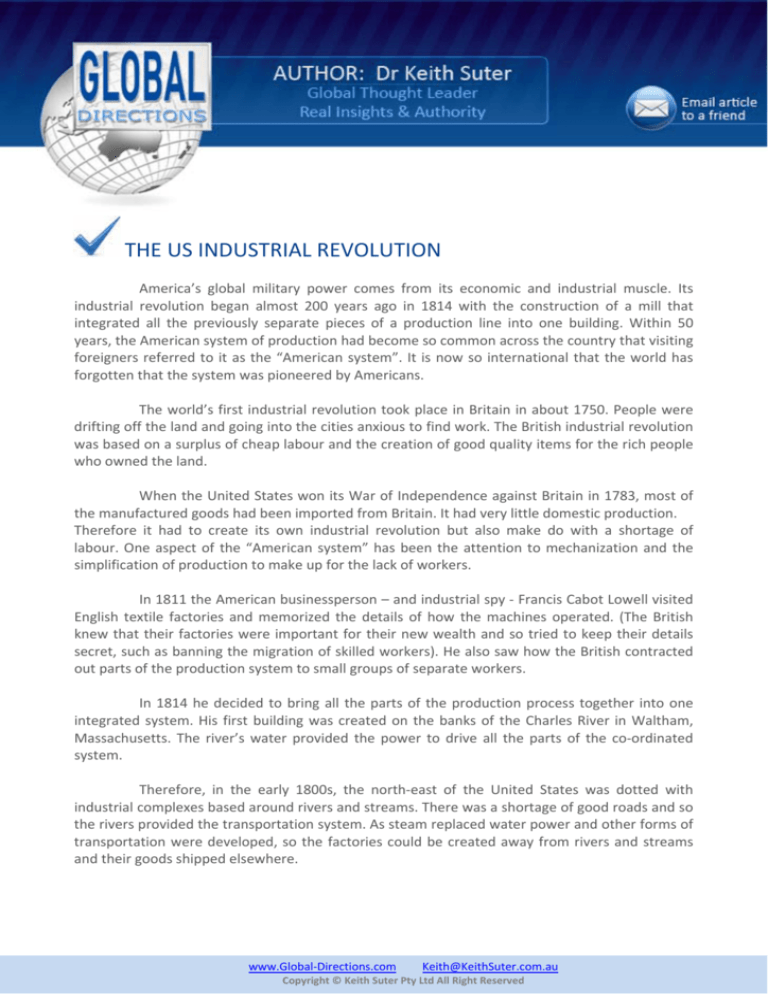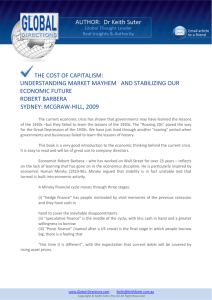
THE US INDUSTRIAL REVOLUTION America’s global military power comes from its economic and industrial muscle. Its industrial revolution began almost 200 years ago in 1814 with the construction of a mill that integrated all the previously separate pieces of a production line into one building. Within 50 years, the American system of production had become so common across the country that visiting foreigners referred to it as the “American system”. It is now so international that the world has forgotten that the system was pioneered by Americans. The world’s first industrial revolution took place in Britain in about 1750. People were drifting off the land and going into the cities anxious to find work. The British industrial revolution was based on a surplus of cheap labour and the creation of good quality items for the rich people who owned the land. When the United States won its War of Independence against Britain in 1783, most of the manufactured goods had been imported from Britain. It had very little domestic production. Therefore it had to create its own industrial revolution but also make do with a shortage of labour. One aspect of the “American system” has been the attention to mechanization and the simplification of production to make up for the lack of workers. In 1811 the American businessperson – and industrial spy ‐ Francis Cabot Lowell visited English textile factories and memorized the details of how the machines operated. (The British knew that their factories were important for their new wealth and so tried to keep their details secret, such as banning the migration of skilled workers). He also saw how the British contracted out parts of the production system to small groups of separate workers. In 1814 he decided to bring all the parts of the production process together into one integrated system. His first building was created on the banks of the Charles River in Waltham, Massachusetts. The river’s water provided the power to drive all the parts of the co‐ordinated system. Therefore, in the early 1800s, the north‐east of the United States was dotted with industrial complexes based around rivers and streams. There was a shortage of good roads and so the rivers provided the transportation system. As steam replaced water power and other forms of transportation were developed, so the factories could be created away from rivers and streams and their goods shipped elsewhere. www.TheGlobalFactor.com.au Keith@KeithSuter.com.au www.Global‐Directions.com Keith@KeithSuter.com.au Copyright © The Global Factor Pty Ltd All Right Reserved Copyright © Keith Suter Pty Ltd All Right Reserved Machine production began in the United States, not because there were so many mechanically skilled people but because there were so few. The British industrial revolution began partly because of all the scientists who lived there. The Americans had few scientists. But the shortage of labour meant that Americans had a greater willingness to experiment and to give things a go. The British industrial revolution was marred by angry mobs of people, who tried to smash new machines fearing that it would cost them their jobs. There were very few instances of angry mobs of labourers in the United States destroying equipment. The British manufacturing system was based on handicraft, reflecting its small scale origins and the meeting of elite consumer tastes. The Americans went for mass production of standardized items that could be easily created by a variety of workers in a variety of locations across the vast United States. For example, British muskets were made individually of high quality by gunsmiths. This meant that every gun was slightly different from the others. The American inventor Whitney aimed to produce muskets from the same format so that the parts were interchangeable. His company went to make to rifles on the same principle. This meant that rifles damaged in battle could be repaired on the field by reassembling items from identical rifles. In 1854, the Crimean War was underway and there were complaints about the poor performance of British rifles. The British War Office sent a team to investigate the “American system”. The team returned to remodel the Small‐arms Factory at Enfield, and so created the Enfield rifle based on the “American system” of production. Another aspect of the “American system” was that of trusting the consumers to pay on instalments. Manufacturers of items like farm machinery (Cyrus McCormick) and sewing machines (Isaac Singer) created a down payment system. Visiting Europeans were amazed that manufacturers would send out goods for consumers to pay off in instalments. In Europe, a person subscribed for something and gradually paid for it – and only getting it when all the payments had been made. Foreigners could not understand how manufacturers would trust the “lower class” of strangers to pay off their goods in instalments. They assumed that such people would disappear as soon as they had received the goods and not continue to make the payments. But the “American system” worked. It created the basis of an unlimited consumer demand that continues to this day. The instalment system was the basis of the current consumer credit system. Newspapers had a role to play. In Europe the newspapers were for elite educated folk who wanted to understand the main issues of the day. But in the United States newspapers were www.Global‐Directions.com Keith@KeithSuter.com.au Copyright © Keith Suter Pty Ltd All Right Reserved a mass circulation item, with articles for all kinds of people. Some of the articles dealt with new inventions and new products and so the newspapers also helped pep up consumer demand. Americans also pioneered machines for fun and freedom. The bicycle was invented in Europe but the “American system” a century ago converted it into a mass production item, with thousands of shops across the country selling and repairing standardized items. The bicycle, used for pleasure, introduced people to many new sights. City folk became aware of farms, woods and streams. Bicycle activities became social events, as well the exercise improving the health of the nation. Photography was invented in France. But again it took the “American system” to move it from being an elite activity to mass production item that could be bought – and used easily ‐ by the millions. Motor cars were also created in Europe but it was Henry Ford who decided that the upper class European plaything could become a mass production item. Daimler in Germany wanted to make beautiful machines that could glide rapidly over the smooth roads. Ford wanted a tough little car that could be produced easily, could withstand America’s primitive road system and could be repaired in small garages across the nation. What it lacked in style it made up for in price and practicality. In short, the British invented the industrial revolution but the Americans invented mass production and we have all benefited from it. Keith Suter
www.TheGlobalFactor.com.au Keith@KeithSuter.com.au www.Global‐Directions.com Keith@KeithSuter.com.au Copyright © The Global Factor Pty Ltd All Right Reserved Copyright © Keith Suter Pty Ltd All Right Reserved



![[#SWF-809] Add support for on bind and on validate](http://s3.studylib.net/store/data/007337359_1-f9f0d6750e6a494ec2c19e8544db36bc-300x300.png)





